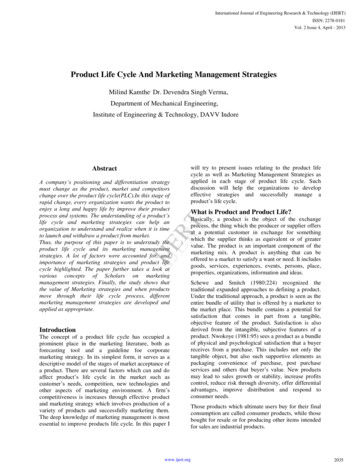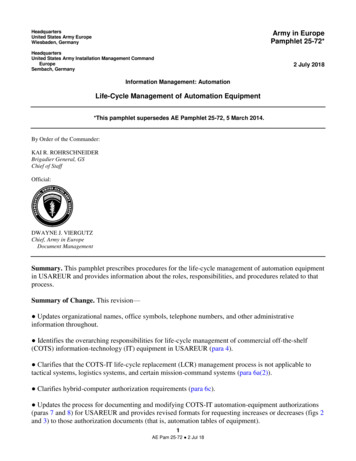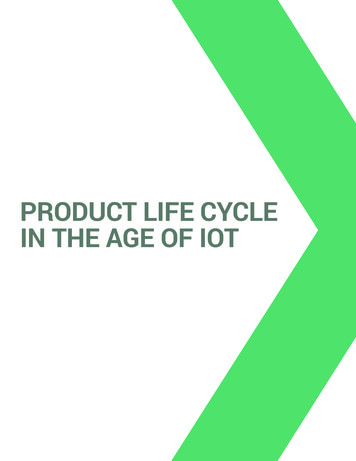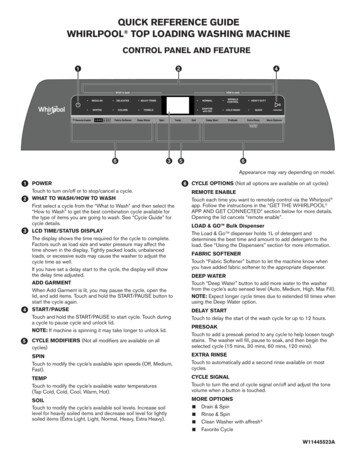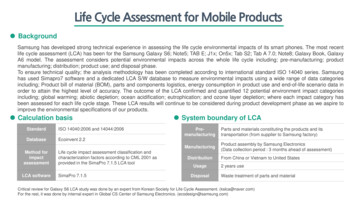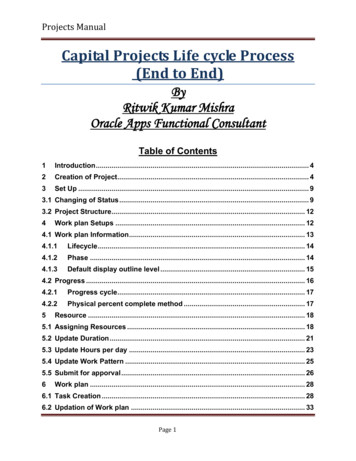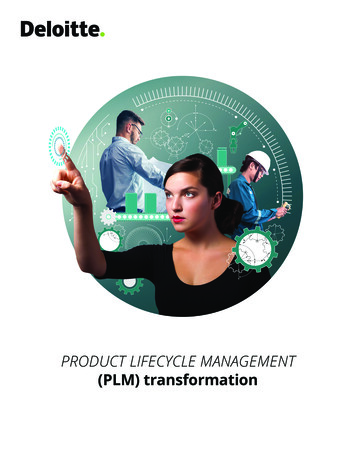
Transcription
PRODUCT LIFECYCLE MANAGEMENT(PLM) transformation
Product Lifecycle Management (PLM) TransformationWhen business leaders across industries are askedwhat it takes to stay ahead of the competition, theyoften say that stronger, more effective, cohesivemanagement across specific areas, such as productdevelopment, manufacturing, finance, and technologyis necessary. However, many manufacturers whoseproducts date back several years are unable to keepup with new processes and technological advancements.Often, their product development processes andinformation are managed within silos. As a result,their processes and systems are likely strained andstruggle to meet goals. They often lack the engineeringefficiency, speed, and flexibility that could make animpact on improving their bottom line.To innovate, structure, and manage product developmentinformation more effectively, many organizations areexploring the use of PLM technologies. However,some organizations are hesitant to undertake thistransformation because of the complexity, the pitfalls,the unknowns, and the cost involved. The initiativepresents the challenge of committing resources andstretching them to yet another long-term project, whilestill trying to keep the business humming along.To remedy this, Deloitte has constructed analternative approach. We offer Deloitte ProductProduct Lifecycle Management (PLM) TransformationLifecycle Management (DPLM), a pre-configuredsolution that can help companies accelerate theirPLM transformations.Another element of uncertainty is the daunting taskof migrating all the structured and unstructured datain legacy systems to the new PLM platform. Our DataMigration Accelerator is a framework and has enabledclients to take on this challenge and helped ensurethat data migration development starts early anddoes not become a bottleneck.Potential Benefits of DPLMRather than gathering requirements from all stakeholdersand spending months in a waterfall methodology todevelop a custom solution from a software toolkit, westart with our pre-configured, industry-tested PLMplatform (DPLM) of processes and applications to manage“gaps” (requirements truly needed by the company)against a proposed solution. This offers an agile approachto deploy, test, and validate updated configurationsand design decisions made throughout the processdesign phase; enabling the program to identify andclose gaps in an iterative fashion.Along with functional evolution, we have a similarapproach for data migration. We have establishedframeworks for migrating data from any structuredor structured data source to DPLM. Our DataMigration Accelerator provides the structure tomap any legacy data (structured or unstructured)to DPLM, migrate it with rapid transform logicdevelopment, and have the business validatethe data to successfully incorporate multiple ETL(extract, transform, load) cycles prior to go-live.Deloitte’s PLM transformation approachDeloitte has a multi-phased approach to enable aclient’s PLM transformation: Assessment andimplementation. In the assessment phase, we helpthe client define and scope their vision, assess theorganization’s current state capabilities, identifyimprovement opportunities, and define the futurestate supported by a phased, multi-year PLM roadmapand business case. The business case drives executivebuy-in on implementation and lays the foundation fordeployment. We have created strategic tools for theassessment phase and developed DPLM that is usedfor a cost-effective and efficient implementation phase.Implementing DPLM can provide the following potential benefits to your organization:15-30%25-50%30-50%10-20%average reduction inimplementation timeline(increased reduction based onfurther complexity reduction ofprocesses and configuration)savings in datamigrations effort andfinal cutover timesavings inimplementation costsimprovement inengineering efficiencyOther potential benefits:DPLM transformation approachImproved engineeringeffectiveness and qualityof the end product03Increased adoption ofleading practice-enrichedprocess designEnforce processstandardization acrossthe organizationProvide efficientinformation flow acrossthe value chain startingwith single source of truthImprove ability to focuson continuousimprovement by monitoringperformance metrics04
Product Lifecycle Management (PLM) TransformationProduct Lifecycle Management (PLM) TransformationDPLM pre-configured solutionDPLM is an “out-of-the-box” pre-configured software solution that leverages Deloitte’s deep experience in leanengineering-focused process design, technology enablement, organizational change, and program management.PLM DESIGNTECHNOLOGY ENABLEMENTPROCESS MODELSC O N F I G U R AT I O NNPDProject ManagementRequirement ManagementDocument ManagementPortfolio ManagementBOM ManagementChange ControlObjectsAttributesAttribute ListWorkflowRolesAccess ControlREQUIREMENTSKPIsD ATA M O D E LCRP IN A BOXEnterprise resource planning (ERP) integrationData migration accelerators for PLMIntegration to leading MCAD, ECAD andReporting and analytics available for eachanalysis and simulation solutionscapability areaIntegration to manufacturing executionOrganizational readiness templatesystem (MES)High-level project planIntegration to technical publication toolsAutomated security validation toolsDPLM: Critical success enablers for transformationDPLM process models incorporate Deloitte’s lean engineering leading practices and include major PLMprocesses to accelerate blueprinting. Our approach starts with out-of-the-box processes and configurationand modifications (approximately 20 percent) where necessary to meet client specific needs. The processesare identified based on the initial assessment and depending on the product mix, we bring together processmaps from multiple industries to create the initial set of base processes. We then start aligning to meet theclient-specific requirements. These processes have requirements, roles, and security definition, and the usecase is tightly linked to provide a detailed requirement for the configuration.TEST MGMTDA SHBOARD& REPORTSD ATA M I G R AT I O NTOOLKITC A D, M E S , E R PI N T E G R AT I O NROLES & RESPONSIBILITIESTransformation toolkitBased on experience with large transformations, we’ve developed a library of templates and tools that canaccelerate the process to mature and deploy the base DPLM solution as per client need. Artifacts that are partof the toolkit include:ORGANIZATION CHANGERequirementslibraryGOVERNANCEMODELO R G A N I Z AT I O N A LREADINESSTR AININGM AT E R I A LMINDSET &B E H AV I O R C H A N G EDesign decisiontemplatesEnd-to-end usecase scenariosand test scriptsTrainingmodules forcore capabilityDeploymentand securityvalidation toolsDPLM integrationDPLM pre-configures integration with most ECAD, MCAD, ERP, and MES solutions. The process implementationfor all capabilities are done to enable the users to visualize how the integrated processes span across theseapplications and how the data from these tools assimilates. Users can execute the process end-to-end fromCAD-PLM-ERP-MES and see how the new process capability addresses the functional requirement.PROGRAM MANAGEMENTPROJEC T PL ANDA SHBOARDSP I L O T S T R AT E G YSpecific elements of DPLM include:Capability Maturity ModelUse cases, roles, and responsibilitiesIntegrated pre-defined processes: newConference room pilot (CRP) materialproduct introduction, project management,requirements management, change control,bill of material (BOM), design for X, and05Key performance indicators (KPIs)Pre-configured data model—objectsdocument managementand attributesBusiness and functional requirementsPre-configured process maps for eachTest cases and scriptscapability area06
Product Lifecycle Management (PLM) TransformationProduct Lifecycle Management (PLM) TransformationData Migration Accelerator (DMA)Getting more from PLMTypical PLM data migration for a PLM transformationcomes with many challenges and risks. It’s also oftenan underestimated high-risk factor in delaying theimplementation, thus increasing overall costs. Puretraditional approaches are too costly to address allmigration risks and challenges. DMA process andtechnical templates help mitigate unknown risks andbring efficiencies, innovation, and productivityimprovements to enable cost and time savings. DMAprovides tools and methods to move data into andfrom PLM systems in a highly efficient manner (1Mobjects per second) and support visualization,searching, analytics, and collaboration.PLM business transformation is a major commitmentregardless of how small or large a change you are making.Here are a few things we have learned that can help:Focus on catalysts. Approaches like DPLM can betailored to specific business processes and designed tohave the capacity to accelerate performance.Get leaner and smarter. Take the time to look at howyou can better streamline your processes to achieveeffective and efficient worker performance and improveproductivity.Stay on target. DPLM can help reduce implementationtime and costs and help drive value for your business.Potential BenefitsDeloitte has helped enable its client to realize the tangible benefits from PLM by improving efficiency, reducingwaste, and improving profitability.Invest in an out-of-the-box solution. DPLM can beadapted to fit your company’s requirements, potentiallysaving you time and money in the long term.CONTAC T SBrian MeekerPrincipalDeloitte Consulting LLP07bmeeker@deloitte.comSamir UppalPrincipalDeloitte Consulting LLPsauppal@deloitte.comMark DavisPrincipalDeloitte Consulting LLPmadavis@deloitte.comVijay SanthanamManaging DirectorDeloitte Consulting LLPvisanthanam@deloitte.comStavros StefanisPrincipalDeloitte Consulting LLPsstefanis@deloitte.comDipen ParikhPrincipalDeloitte Consulting LLPdiparikh@deloitte.com08
About DeloitteDeloitte refers to one or more of Deloitte Touche Tohmatsu Limited, a UK private company limitedby guarantee (“DTTL”), its network of member firms, and their related entities. DTTL and each ofits member firms are legally separate and independent entities. DTTL (also referred to as “DeloitteGlobal”) does not provide services to clients. In the United States, Deloitte refers to one or more ofthe US member firms of DTTL, their related entities that operate using the “Deloitte” name in theUnited States and their respective affiliates. Certain services may not be available to attest clientsunder the rules and regulations of public accounting. Please see www.deloitte.com/about to learnmore about our global network of member firms.Copyright 2019 Deloitte Development LLC. All rights reserved
document management Business and functional requirements Test cases and scripts Use cases, roles, and responsibilities Conference room pilot (CRP) material Key performance indicators (KPIs) Pre-configured data model—objects and attributes Pre-configured process maps for each capab



